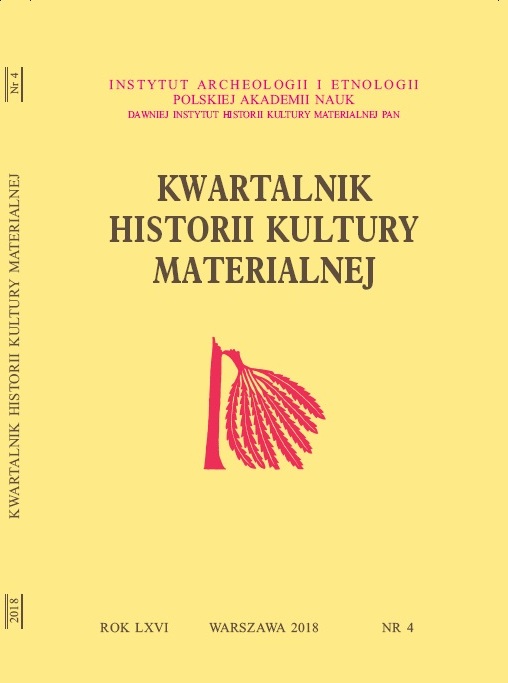"His sun set at noon". Verbal and pictorial representations of death on Jewish headstones in Poland in the 13th-20th c.
Keywords:
Poland, Jews, headstones, iconologyAbstract
The article discusses verbal and pictorial representations of transience and passing away found on Jewish headstones in Polish territories from the 13th to the 20th c. (before the Holocaust). The analysis includes inscriptions, decorative motifs and forms of gravestones. Hebrew gravestone inscriptions avoided direct references to death, which resulted in using many euphemisms and periphrases. The author notes 57 verbal and four nominal expressions of this type. The former group includes several different verbal roots referring to each of the following concepts: ‘going away’, ‘leaving’, ‘fading away’, ‘tearing out’. This multitude of expressions was connected on the one hand with the Jewish tradition of avoiding direct mentions of death and mitigating literal reference to drastic experiences, and on the other with the deve-lopment of Hebrew epitaph poetry and the revival of the Hebrew language in the 19th c. The analysis concerns traditional epitaphs, leaving aside inscriptions from the graves of Jews assimilated in Christian culture, since this was a separate phenomenon, which started in the mid-19th c. The ornamentation of matzevahs had not included vanitas motifs until the 19th c.; only then did they start to be introduced, in consequence of the Jewish enlightenment and processes of acculturation and assimilation, in two ways. One way was to modify the widely used traditional images, e.g. plant motifs (trees or flowers) representing the tree of eternal life: their cutting, cleaving or withering acquired a new symbolic signifi cance. A fl ower, a twig and a tree became symbols of individual existence, of its transience and of death. Other common motifs were: a broken or extinguished candle, a forlorn fl ock of sheep or birds, a setting sun, an upturned crown. The other way was to adopt motifs (and gravestone forms) from non-Jewish sepulchral culture, e.g. an extinguished torch, a broken pillar, an urn covered with a pall, a coffi n on a catafalque, an hourglass, an ouroboros, a butterfl y, a poppy. Since the 19th c. both ways of representing death were used on headstones, but the co-occurrence of consciously chosen converging inscriptions and images was uncommon.
Downloads
References
Biblia. 1979. Biblia to jest Pismo Święte Starego i Nowego Testamentu, nowy przekł. z jęz. hebrajskiego i greckiego, Warszawa.
Boccato Carla. 1981. The Ancient Jewish Cemetery of San Nicolo on the Lido in Venice, Venice.
Frey Jean-Baptiste. 1936. Corpus Inscriptionum Iudaicarum. Recueil des inscriptions juives qui vont du IIIe siècle avant Jésus-Christ au VIIe siècle de notre ère, t. 1 : Europe, Roma.
Frey Jean-Baptiste. 1952. Corpus Inscriptionum Judaicarum II. Asie, Afrique, Roma.
Goodenough Erwin R. 1953–1968. Jewish Symbols in the Greco-Roman Period, t. 1–13, New York.
Hachlili Rachel. 1988. Ancient Jewish Art and Archeology in the Land of Israel, Leiden.
Hachlili Rachel. 1998. Ancient Jewish Art and Archeology in the Diaspora, Leiden.
Hońdo Leszek. 1999. Stary żydowski cmentarz w Krakowie. Historia cmentarza. Analiza hebrajskich inskrypcji, Kraków.
Krajewska Monika. 1989. Symbolika płaskorzeźb na cmentarzach żydowskich w Polsce, „Polska Sztuka Ludowa”, R. XLIII, nr 1–2, s. 45–59.
Krajewska Monika. 1993. A Tribe of Stones. Jewish Cemeteries in Poland. Photographs, Text, Tombstone Rubbings and Selection of Mottoes, Introduction by R. Scharf, Warsaw.
Levy Arthur. 1924. Judische Grabmalkunst in Osteuropa. Eine Sammlung, Berlin.
Sefer Tora newijim u-ketuwim. 1982. [nadzór] Norman Henry Snaith, London.
Seidman Hilel. 1934. Szlakiem nauki talmudycznej. Wiedza judaistyczna a wyższa uczelnia talmudyczna w Lublinie, Warszawa.
TB. Talmud Bavli, The William Davidson Talmud. 2017. Digital edition of the Koren Noé Talmud, with commentary by Rabbi Adin Even-Israel Steinsaltz, http://www.sefaria.org/texts/Talmud
Trzciński Andrzej. 1997. Symbole i obrazy. Treści symboliczne przedstawień na nagrobkach żydowskich w Polsce, Lublin.
Trzciński Andrzej. 2017. Świadkiem jest ta stela. Stary cmentarz żydowski w Lublinie, Lublin.
van Der Horst Pieter W. 1991. Ancient Jewish Epitaphs: an Introductory Survey of a Millennium of Jewish Funerary Epigraphy (300 BCE–700 CE), Kampen.
Vega Louis A. 1979. Het Beth Haim van Ouderkerk. Beelden van een Portugees-Joodse Begraafplaats, Assen.
Wodziński Marcin. 1996. Hebrajskie inskrypcje na Śląsku XVII–XVIII wieku, Wrocław.
Woronczak Jan Paweł. 1999. „Cmentarz żydowski w Kromołowie jako tekst kultury”, t. 1–2, Wrocław (mpis rozprawy doktorskiej, archiwum Instytutu Filologii Polskiej, Uniwersytet Wrocławski).
Downloads
Published
How to Cite
Issue
Section
License

This work is licensed under a Creative Commons Attribution-NonCommercial-NoDerivatives 4.0 International License.





 Publication co-financed by the Ministry of Science and Higher Education under the program "Support for scientific journals 2019-2020"
Publication co-financed by the Ministry of Science and Higher Education under the program "Support for scientific journals 2019-2020"








